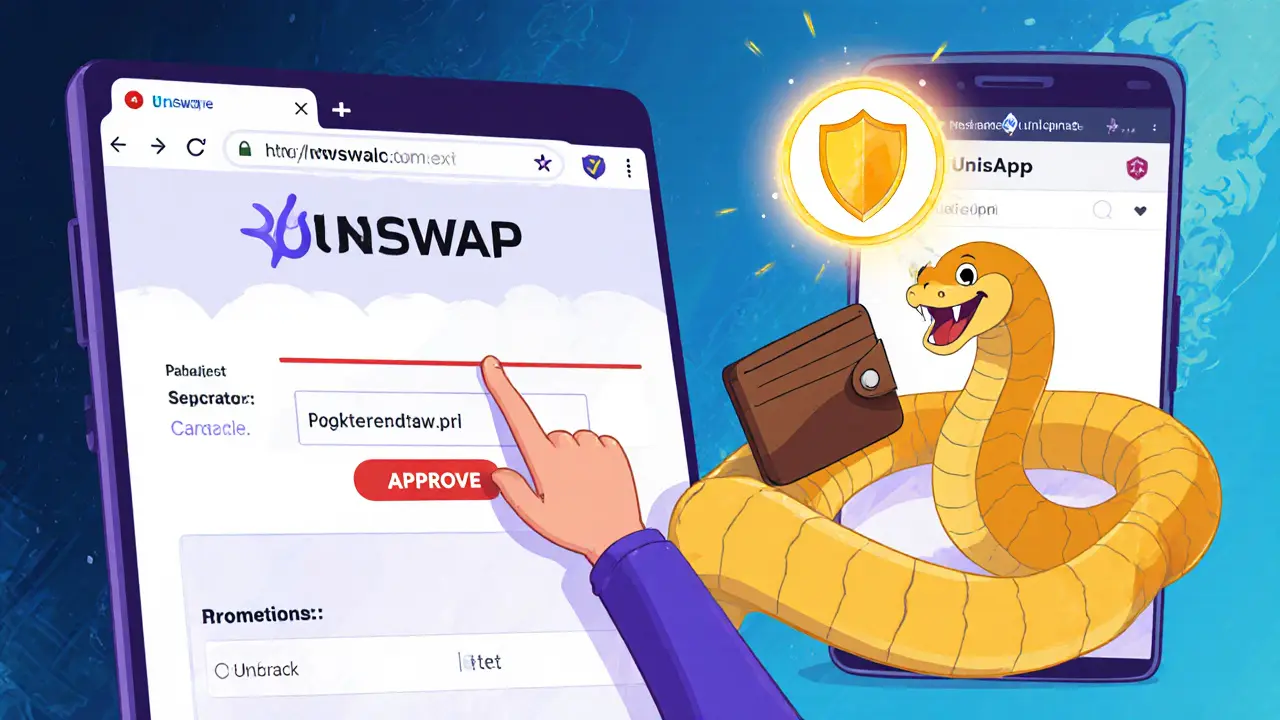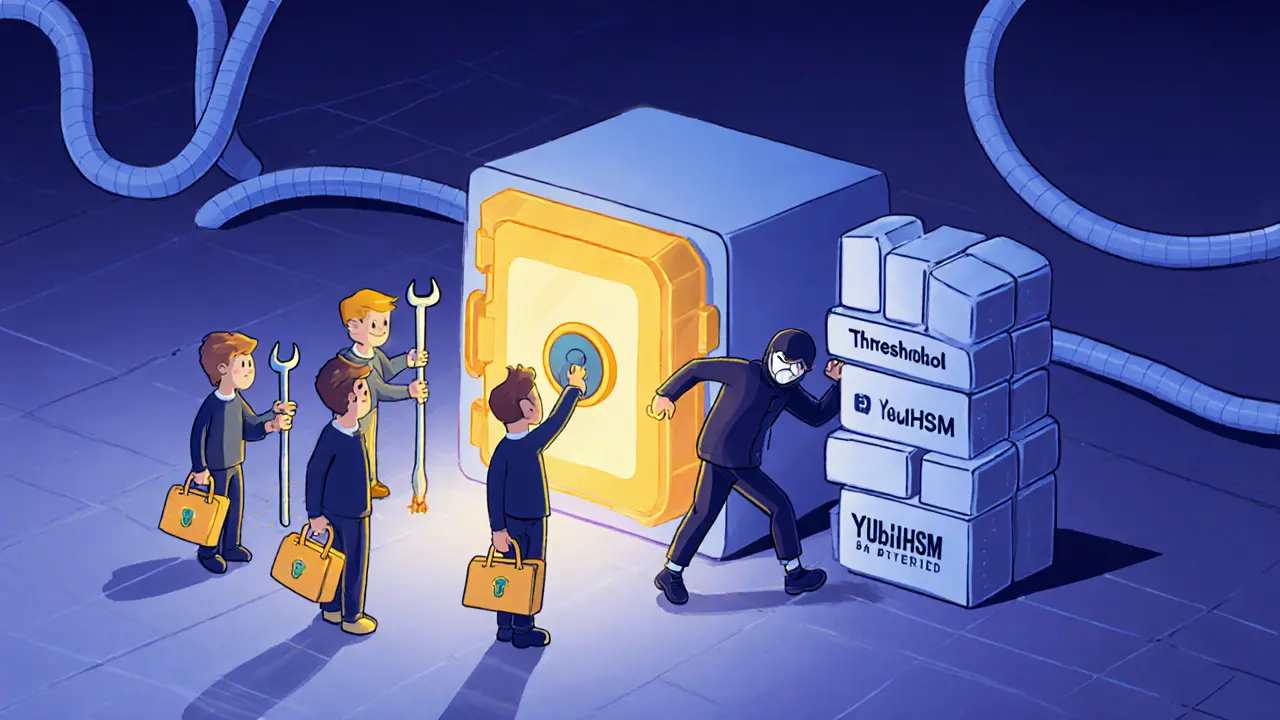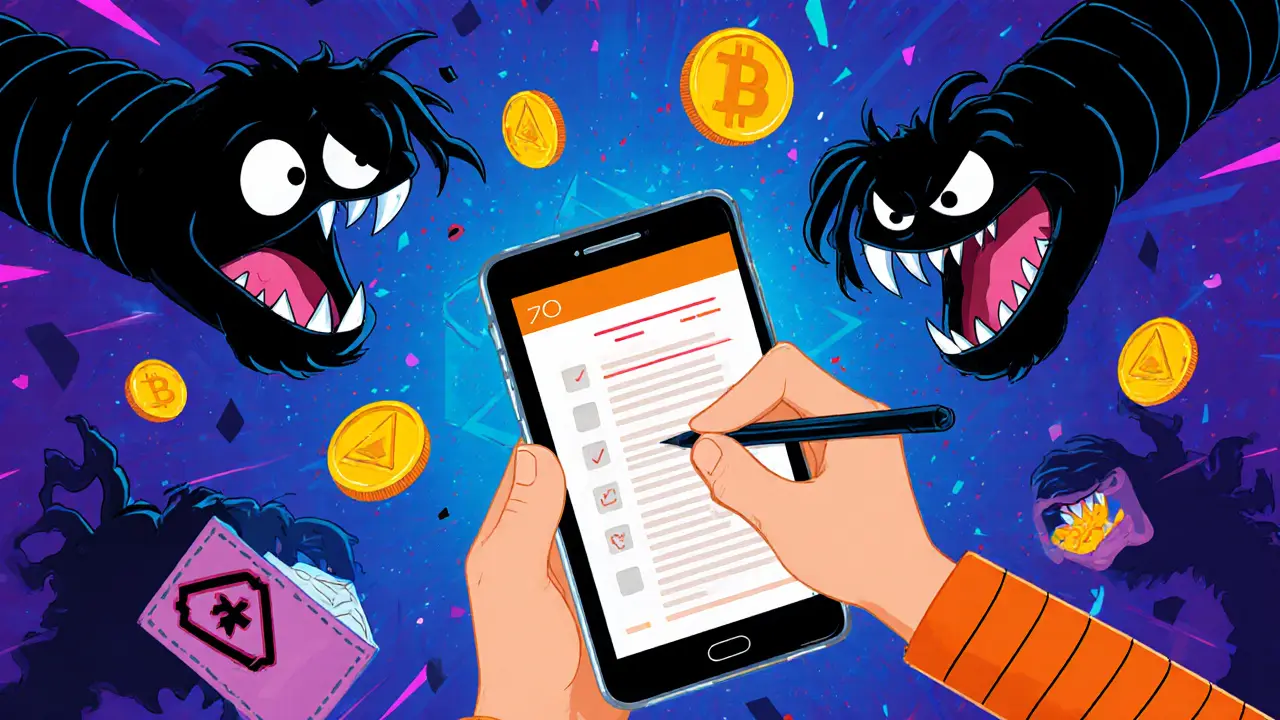Contract Address Security Checker
Why This Matters
90% of dApp thefts happen when users sign malicious transactions. Always verify contract addresses before approving transactions. This tool checks addresses against known scam databases and Etherscan.
Security Tip Never sign transactions without seeing the exact token symbol and amount.
Important Safety Practices
ALWAYS:
- Verify contract addresses on Etherscan
- Check token approvals before signing
- Never click links from Twitter/Discord
- Use separate wallets for different dApp activities
When you interact with a dApp-whether swapping tokens on a decentralized exchange, minting an NFT, or voting in a DAO-you’re trusting code that runs on a public blockchain. There’s no customer support line. No central server to reset your password. If something goes wrong, your funds are gone for good. That’s why dApp security isn’t optional-it’s the foundation of every safe Web3 experience.
Smart Contracts Are the Core, Not Just a Feature
Most dApp vulnerabilities live in the smart contract layer. These are self-executing programs on blockchains like Ethereum, and they handle everything from token transfers to governance votes. A single line of bad code can drain millions. The OWASP Smart Contract Security Verification Standard (SCSVS), released in draft form in September 2024, is the first industry-wide effort to standardize how these contracts are built and tested. It doesn’t just list risks-it gives developers a checklist.Common flaws include reentrancy attacks, where a malicious contract calls back into yours before the first transaction finishes, draining funds. Overflow and underflow bugs happen when arithmetic operations exceed the maximum or minimum value a variable can hold, turning a $100 balance into $0-or worse, $10^77. These aren’t theoretical. In 2022, a single reentrancy bug in a DeFi protocol cost users over $60 million. Audits aren’t a one-time box to check. They need to be continuous, updated with every new feature.
Frontend Tricks Are the #1 Way Users Get Hacked
You might think the blockchain itself is the weak point. But 90% of dApp thefts happen because users are tricked into signing malicious transactions. Fake websites that look like Uniswap or OpenSea are everywhere. They copy the UI perfectly-down to the logo and color scheme. The only difference? The contract address.Always verify the contract address before approving any transaction. Legit dApps show the full address on-screen and link to it on Etherscan or other block explorers. If you’re being asked to approve a token transfer without seeing the exact token symbol and amount, walk away. Many phishing sites hide malicious approvals inside multi-step flows-like a fake NFT mint that first asks you to approve unlimited spending on your ERC-20 tokens. Once you sign that, they can drain your wallet anytime.
Use wallet extensions with built-in transaction previews. MetaMask and Rabby show you exactly what you’re signing: which contract, what function, and what data. Never ignore the details. If you see something like approve(0x...) without a clear token name, cancel it. That’s not a normal transaction-it’s a trap.
Decentralization Isn’t Just a Buzzword-It’s a Security Layer
Not all dApps are created equal. Some are fully decentralized. Others are just websites with a wallet button, controlled by a single developer or company. The level of decentralization directly affects how secure a dApp is.If a dApp uses a central server to store user data or manage keys, it’s vulnerable to server breaches. Even if the blockchain is secure, the off-chain component becomes the weakest link. True decentralization means control is spread across multiple parties. For example, some dApps on the Internet Computer use canister controllers that require 3 out of 5 team members to approve any change. That’s called a multisig control system.
Enterprise-grade dApps use hardware security modules (HSMs) like YubiHSM to store private keys. These devices are physically secured, often kept in safes across different cities. Some even support threshold signatures, where no single person can act alone. If your favorite dApp doesn’t explain how it manages keys, assume it’s not secure.

Privacy Isn’t Optional-It’s Built Into Secure dApps
On public blockchains, every transaction is visible. That’s a problem if you’re trading large amounts or using a dApp for sensitive purposes. Zero-knowledge proofs (ZKPs) solve this. They let you prove you’re eligible for a loan, or that you own a token, without revealing your balance or identity.Some dApps now integrate decentralized identity systems like the Gateway Protocol. This lets users control what data they share. Instead of giving a dApp full access to your wallet history, you can prove you’ve held a token for 30 days without showing how many you own. This reduces attack surface and protects users from targeted scams.
Pseudonymous identities-consistent usernames tied to your wallet but not your real name-are another layer. They let you build reputation across dApps without exposing personal info. But even these can be tracked. The most secure dApps give you the choice: disclose only what’s necessary, and nothing more.
What You Can Do Right Now
You don’t need to be a developer to protect yourself. Here’s what works:- Always check the contract address before signing anything. Bookmark official sites. Never click links from Twitter or Discord.
- Use a separate wallet for dApps-don’t put your main ETH holdings in a wallet you use for NFTs or DeFi.
- Set token approval limits. Never allow “unlimited” approvals. Use tools like Etherscan to revoke old approvals you no longer need.
- Enable transaction confirmations in your wallet. Turn on warnings for high-risk contracts.
- Never share your seed phrase. No legitimate dApp will ever ask for it.
- Use wallet analytics tools like Revoke.cash to see which contracts have access to your tokens-and cut off what you don’t use.

The Biggest Threat Isn’t Code-It’s Complacency
Rug pulls, phishing scams, and smart contract exploits aren’t new. But they keep working because people assume “it’s blockchain, so it’s safe.” It’s not. The blockchain is immutable, not infallible. The code can be broken. The interface can be faked. The user can be fooled.The most secure dApp in the world is useless if you click a link from a fake tweet. The best audit means nothing if you approve a transaction without reading it. Security isn’t a feature-it’s a habit.
Start treating every transaction like you’re handing cash to a stranger on the street. Ask: Who am I giving this to? What are they allowed to do? Can I undo this? If you can’t answer those questions, don’t sign.
What’s Next for dApp Security
The industry is moving fast. Tools like LaunchTrail are making it easier to track changes to dApp code, so users can see who made what update and when. DAOs are adopting governance systems like SNS (Service Nervous System) to let token holders vote on upgrades without central control.But the biggest shift is cultural. Developers are starting to treat security like a product feature-not an afterthought. Teams now hire dedicated auditors before launch. Security budgets are rising. And standards like OWASP SCSVS are pushing the whole ecosystem toward consistency.
For users, this means more transparency. More warnings. More control. But until every dApp follows best practices, your vigilance is still the last line of defense.

Comments (15)
LaTanya Orr
November 22, 2025 AT 05:00
It's wild how we treat dApps like they're magic boxes that just work
But honestly, if you're not checking contract addresses like your life depends on it, you're already one click away from losing everything
I keep a spreadsheet of every dApp I've ever interacted with and when I revoked access
It's not glamorous but it's saved me twice
Ashley Finlert
November 23, 2025 AT 14:27
The true tragedy of Web3 isn't the bugs in the code-it's the erosion of human caution
We've replaced trust in institutions with blind faith in algorithms
And yet, the most vulnerable part of this entire system remains the human who clicks 'approve' without reading
Security isn't a protocol-it's a mindset cultivated through humility and vigilance
Every transaction is a mirror: it reveals whether we're still masters of our own choices
Or just willing participants in a digital gamble we don't fully understand
Chris Popovec
November 25, 2025 AT 03:34
OWASP SCSVS? LOL
That’s just corporate theater
Real security? You don’t use MetaMask
You use a cold wallet with a paper backup stored in a fucking safe in a different country
And you never, ever connect your wallet to any website unless you’ve verified the TLS cert manually
Also, all dApps are backdoored-don’t be naive
Even the ‘decentralized’ ones have a kill switch hidden in the code
Trust no one, not even the blockchain
Marilyn Manriquez
November 26, 2025 AT 06:46
Security in decentralized systems is not merely a technical challenge-it is a profound social contract
Each user must become an active steward of their own digital sovereignty
Complacency is the silent thief
And vigilance, the only true armor
Let us rise to this responsibility with discipline and grace
taliyah trice
November 27, 2025 AT 12:43
Just don't click links from Twitter and you'll be fine
Charan Kumar
November 27, 2025 AT 18:11
Bro I use trust wallet and never had issue
But yeah always check contract
One time I saw a fake opensea and almost signed
Thank god I checked address
Now I bookmark everything
Also never give unlimited approval
That's just asking for trouble
Peter Mendola
November 28, 2025 AT 10:29
90% of thefts = user error.
Case closed.
😂
Terry Watson
November 29, 2025 AT 21:49
Wait-did you just say 'a single line of bad code can drain millions'?
That’s not just a vulnerability-that’s a systemic failure of human oversight!
And yet we still treat this like a game?
Do you realize how insane it is that we’re entrusting life savings to code written by 19-year-olds who got paid in ETH?
And then we call it ‘decentralized finance’?
It’s not finance-it’s digital Russian roulette with a 70% chance of losing everything
And the worst part? We keep playing because we’re addicted to the hype
Not because we understand the risk
It’s not a feature-it’s a catastrophe waiting to be monetized
Sunita Garasiya
November 30, 2025 AT 07:18
Oh wow so the solution to crypto scams is... reading?
Groundbreaking.
Next you'll tell me not to touch hot stoves
Meanwhile I'm over here watching people approve 'unlimited' on a contract called 'freeNFT123' with a .xyz domain
And they're like 'but it's decentralized!'
Yes, honey. So is the abyss
Mike Stadelmayer
November 30, 2025 AT 14:50
Been using dApps since 2018
Lost a few grand to phishing
Now I use a burner wallet for everything
Only connect to sites I’ve typed in myself
And I revoke approvals every month like it's laundry
It's not hard
Just annoying
But way better than losing your life savings
Also-yes, bookmark the real sites
Twitter links are death traps
Norm Waldon
December 1, 2025 AT 19:31
OWASP? Please.
They’re just another globalist tool to standardize vulnerability.
The real threat isn’t smart contracts-it’s the fact that American tech firms are pushing these platforms into developing nations under the guise of 'financial inclusion'
Meanwhile, the backend is controlled by a handful of VC-backed entities in Silicon Valley
And you think you’re 'decentralized'? You’re a data point
They want your wallet history, your transaction patterns, your behavioral biometrics
Everything you do is logged, sold, and weaponized
Don’t be fooled-this isn’t freedom
It’s surveillance with a blockchain sticker
neil stevenson
December 3, 2025 AT 03:57
Yessss this is why I only use Rabby now 😎
Also never approve anything without checking the token symbol
One time I almost signed a 'USDC' approval and it was actually 'USDCv2' with a different contract
Thank god Rabby flagged it
Also-always revoke old approvals
Revoke.cash is my best friend 🙌
Samantha bambi
December 4, 2025 AT 02:43
I appreciate how this post breaks down both technical and behavioral risks
Too many people focus only on the code and forget the human element
Security is a combination of tools and habits
And the most powerful tool? Awareness
Thank you for writing this with such clarity and urgency
It’s exactly what the community needs right now
Anthony Demarco
December 5, 2025 AT 06:02
Everyone talks about smart contracts but nobody talks about how the entire system is designed to exploit the poor
You think a farmer in India or a single mom in Detroit has time to learn contract addresses?
They get phished because they’re desperate to get ahead
And then we call them 'gullible'
Meanwhile, the devs who made these platforms are sipping champagne in Miami
Security isn’t the problem
The system is
Jack Richter
December 5, 2025 AT 15:33
Yeah ok
Guess I’ll just stop using crypto then